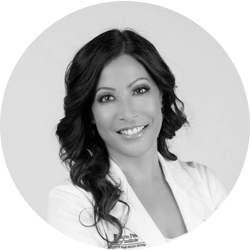supported by


Wendy W. Lee, MD
Dr. Lee is an Associate Professor of Clinical Ophthalmology and Dermatology, Oculofacial Plastic & Reconstructive Surgery, Orbit and Oncology, at the Bascom Palmer Eye Institute, University of Miami Miller School of Medicine, in Miami, Florida.
Please share with us your background.
I was born and raised in northern California by my mother, a retired nurse, and my father, a retired high school teacher, alongside two older sisters and two younger brothers. I received my undergraduate degree in biological sciences at the University of California at Santa Barbara. I then moved to Washington, DC, to complete my Master of Science in Physiology from Georgetown University.
Medical school in New Orleans is where I met my husband, Michael Lee, who was in the class ahead of me at Tulane University. We were married in San Francisco shortly after I graduated. We both stayed at Tulane to complete our internships and residencies, his in obstetrics and gynecology and mine in ophthalmology.
During my third year of residency, we had our first child, Michael Christian. When Michael was 4 months old, we moved to Miami, where I completed my fellowship in ophthalmic plastic and reconstructive surgery at the Bascom Palmer Eye Institute. Toward the end of my fellowship, we welcomed our second baby boy, James Henry. Months after James was born, I began my faculty position at Bascom Palmer, where I see the myriad of oculoplastic disorders and also direct the Institute’s Aesthetic Center and UM Cosmetic Medicine.
What is the focus of your current research?
My research is varied and includes orbital tumor markers, aesthetic applications in ophthalmology, the aging of eyelid skin, refractive changes after eyelid surgery, anesthesia with eyelid surgery, trauma, and regeneration of the conjunctiva.
What has your experience been collaborating with industry?
I have multiple fantastic relationships with industry, both on the aesthetic side and the eye care side. I have found that the companies I work most closely with, from the large down to the very small, have leadership and representatives who are passionate and dedicated to their clients. This aspect has really helped with relationship building. I thoroughly enjoy being a key opinion leader for many of the companies and also participating in instrument and device design.
In your opinion, how is the role of women in ophthalmology evolving?
First of all, the percentage of female ophthalmologists has risen over the past few years, following the trend of increasing female presence in medicine overall. The number of women leaders in ophthalmology is also on the rise. We have had female presidents of the American Academy of Ophthalmology (AAO), and there are currently many female department chairs and multiple women who play significant leadership roles in the academic setting, in the private sector, and in the community. Our role in ophthalmology is also evolving thanks to the various women’s groups within our specialty, including Women in Ophthalmology (WIO), Ophthalmic Women Leaders (OWL), and the American Society of Progressive Enterprising Surgeons (ASPENS), which lend support and nourish careers of women in our field.
What, if any, hurdles do you feel women in health care still face?
Women are still climbing uphill when it comes to medicine and even more so in a surgical subspecialty, as we remain in the minority. We compete most of the time with men when it comes to obtaining leadership roles. The cultural norms and some implicit values, especially at academic institutions, can contribute to challenges women face when attempting to prove their abilities, skill, knowledge, endurance, and drive.
Statistics still show that women’s salaries are lower than men’s, and women have traditionally lower success rates when it comes to negotiation. Fortunately, this uphill climb is not nearly as steep as it was in the past. Playing fields are much more even, and women and men tend to work together as a team, supporting, encouraging, and learning from each other.
Regarding work-life balance, nature granted women the eternal gift of hurdles, until babies start coming out of men’s bodies ;). If women choose to have families, time needs to be allotted and schedules adjusted to harmoniously fit both into daily life. This choice takes dedication and commitment, as most choices in life do.
All this being said, I find it invigorating to be in this type of environment, where challenge is never in paucity and achievement is exhilarating.
What advice can you offer to young female ophthalmologists who are still in training or just beginning their careers?
Stay focused and motivated. Be confident in your skills. Don’t settle, but follow your heart and go after what your true passions are. Strive for your highest goals and don’t feel intimidated by your surroundings. Always put forth your best effort. Once others see your raw talent and the hard work you put forth to get to where you are, your career will blossom. Realize that you can have it all: a successful career and a great personal life.
Can you propose a unique or creative idea that may help women in ophthalmic practices?
Market yourself as a confident, skilled surgeon, who also has compassion for her patients. Make connections and get involved in local and/or national media. Donate to local charities and fundraisers. Have special events at the office offering attractive promotions to your patients, whether aesthetic, retail, or functional.


